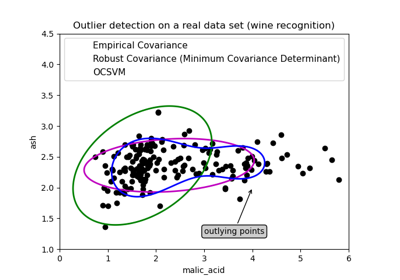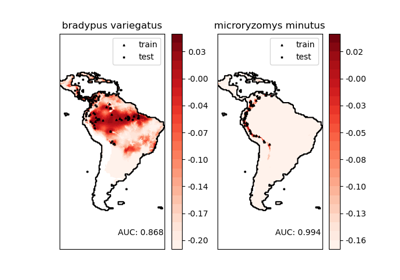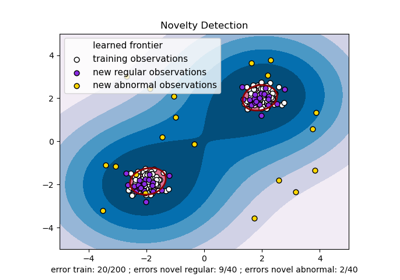sklearn.svm.OneClassSVM¶
- class sklearn.svm.OneClassSVM(*, kernel='rbf', degree=3, gamma='scale', coef0=0.0, tol=0.001, nu=0.5, shrinking=True, cache_size=200, verbose=False, max_iter=-1)[source]¶
Unsupervised Outlier Detection.
Estimate the support of a high-dimensional distribution.
The implementation is based on libsvm.
Read more in the User Guide.
- Parameters:
- kernel{‘linear’, ‘poly’, ‘rbf’, ‘sigmoid’, ‘precomputed’} or callable, default=’rbf’
Specifies the kernel type to be used in the algorithm. If none is given, ‘rbf’ will be used. If a callable is given it is used to precompute the kernel matrix.
- degreeint, default=3
Degree of the polynomial kernel function (‘poly’). Ignored by all other kernels.
- gamma{‘scale’, ‘auto’} or float, default=’scale’
Kernel coefficient for ‘rbf’, ‘poly’ and ‘sigmoid’.
if
gamma='scale'(default) is passed then it uses 1 / (n_features * X.var()) as value of gamma,if ‘auto’, uses 1 / n_features.
Changed in version 0.22: The default value of
gammachanged from ‘auto’ to ‘scale’.- coef0float, default=0.0
Independent term in kernel function. It is only significant in ‘poly’ and ‘sigmoid’.
- tolfloat, default=1e-3
Tolerance for stopping criterion.
- nufloat, default=0.5
An upper bound on the fraction of training errors and a lower bound of the fraction of support vectors. Should be in the interval (0, 1]. By default 0.5 will be taken.
- shrinkingbool, default=True
Whether to use the shrinking heuristic. See the User Guide.
- cache_sizefloat, default=200
Specify the size of the kernel cache (in MB).
- verbosebool, default=False
Enable verbose output. Note that this setting takes advantage of a per-process runtime setting in libsvm that, if enabled, may not work properly in a multithreaded context.
- max_iterint, default=-1
Hard limit on iterations within solver, or -1 for no limit.
- Attributes:
- class_weight_ndarray of shape (n_classes,)
Multipliers of parameter C for each class. Computed based on the
class_weightparameter.coef_ndarray of shape (1, n_features)Weights assigned to the features when
kernel="linear".- dual_coef_ndarray of shape (1, n_SV)
Coefficients of the support vectors in the decision function.
- fit_status_int
0 if correctly fitted, 1 otherwise (will raise warning)
- intercept_ndarray of shape (1,)
Constant in the decision function.
- n_features_in_int
Number of features seen during fit.
New in version 0.24.
- feature_names_in_ndarray of shape (
n_features_in_,) Names of features seen during fit. Defined only when
Xhas feature names that are all strings.New in version 1.0.
- n_iter_int
Number of iterations run by the optimization routine to fit the model.
New in version 1.1.
n_support_ndarray of shape (n_classes,), dtype=int32Number of support vectors for each class.
- offset_float
Offset used to define the decision function from the raw scores. We have the relation: decision_function = score_samples -
offset_. The offset is the opposite ofintercept_and is provided for consistency with other outlier detection algorithms.New in version 0.20.
- shape_fit_tuple of int of shape (n_dimensions_of_X,)
Array dimensions of training vector
X.- support_ndarray of shape (n_SV,)
Indices of support vectors.
- support_vectors_ndarray of shape (n_SV, n_features)
Support vectors.
See also
sklearn.linear_model.SGDOneClassSVMSolves linear One-Class SVM using Stochastic Gradient Descent.
sklearn.neighbors.LocalOutlierFactorUnsupervised Outlier Detection using Local Outlier Factor (LOF).
sklearn.ensemble.IsolationForestIsolation Forest Algorithm.
Examples
>>> from sklearn.svm import OneClassSVM >>> X = [[0], [0.44], [0.45], [0.46], [1]] >>> clf = OneClassSVM(gamma='auto').fit(X) >>> clf.predict(X) array([-1, 1, 1, 1, -1]) >>> clf.score_samples(X) array([1.7798..., 2.0547..., 2.0556..., 2.0561..., 1.7332...])
Methods
Signed distance to the separating hyperplane.
fit(X[, y, sample_weight])Detect the soft boundary of the set of samples X.
fit_predict(X[, y])Perform fit on X and returns labels for X.
get_params([deep])Get parameters for this estimator.
predict(X)Perform classification on samples in X.
Raw scoring function of the samples.
set_params(**params)Set the parameters of this estimator.
- property coef_¶
Weights assigned to the features when
kernel="linear".- Returns:
- ndarray of shape (n_features, n_classes)
- decision_function(X)[source]¶
Signed distance to the separating hyperplane.
Signed distance is positive for an inlier and negative for an outlier.
- Parameters:
- Xarray-like of shape (n_samples, n_features)
The data matrix.
- Returns:
- decndarray of shape (n_samples,)
Returns the decision function of the samples.
- fit(X, y=None, sample_weight=None, **params)[source]¶
Detect the soft boundary of the set of samples X.
- Parameters:
- X{array-like, sparse matrix} of shape (n_samples, n_features)
Set of samples, where
n_samplesis the number of samples andn_featuresis the number of features.- yIgnored
Not used, present for API consistency by convention.
- sample_weightarray-like of shape (n_samples,), default=None
Per-sample weights. Rescale C per sample. Higher weights force the classifier to put more emphasis on these points.
- **paramsdict
Additional fit parameters.
Deprecated since version 1.0: The
fitmethod will not longer accept extra keyword parameters in 1.2. These keyword parameters were already discarded.
- Returns:
- selfobject
Fitted estimator.
Notes
If X is not a C-ordered contiguous array it is copied.
- fit_predict(X, y=None)[source]¶
Perform fit on X and returns labels for X.
Returns -1 for outliers and 1 for inliers.
- Parameters:
- X{array-like, sparse matrix} of shape (n_samples, n_features)
The input samples.
- yIgnored
Not used, present for API consistency by convention.
- Returns:
- yndarray of shape (n_samples,)
1 for inliers, -1 for outliers.
- get_params(deep=True)[source]¶
Get parameters for this estimator.
- Parameters:
- deepbool, default=True
If True, will return the parameters for this estimator and contained subobjects that are estimators.
- Returns:
- paramsdict
Parameter names mapped to their values.
- property n_support_¶
Number of support vectors for each class.
- predict(X)[source]¶
Perform classification on samples in X.
For a one-class model, +1 or -1 is returned.
- Parameters:
- X{array-like, sparse matrix} of shape (n_samples, n_features) or (n_samples_test, n_samples_train)
For kernel=”precomputed”, the expected shape of X is (n_samples_test, n_samples_train).
- Returns:
- y_predndarray of shape (n_samples,)
Class labels for samples in X.
- score_samples(X)[source]¶
Raw scoring function of the samples.
- Parameters:
- Xarray-like of shape (n_samples, n_features)
The data matrix.
- Returns:
- score_samplesndarray of shape (n_samples,)
Returns the (unshifted) scoring function of the samples.
- set_params(**params)[source]¶
Set the parameters of this estimator.
The method works on simple estimators as well as on nested objects (such as
Pipeline). The latter have parameters of the form<component>__<parameter>so that it’s possible to update each component of a nested object.- Parameters:
- **paramsdict
Estimator parameters.
- Returns:
- selfestimator instance
Estimator instance.
Examples using sklearn.svm.OneClassSVM¶
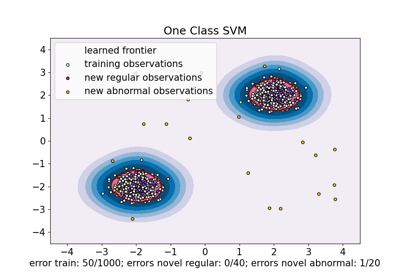
One-Class SVM versus One-Class SVM using Stochastic Gradient Descent
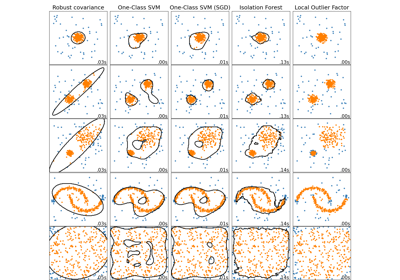
Comparing anomaly detection algorithms for outlier detection on toy datasets


